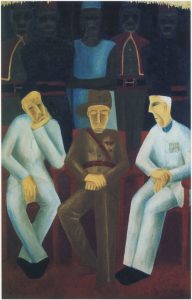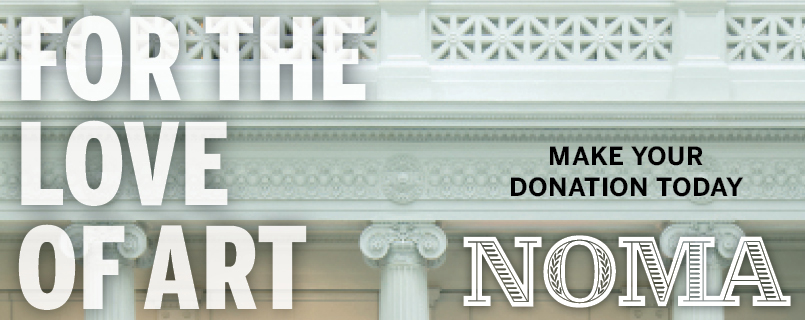
Demas Nwoko, Nigeria in 1959, 1960. Oil on board, 53 × 38 in. Collection of the artist/New Culture Studios, Ibadan. Photo: Courtesy of the National Gallery of Art, Abuja, Nigeria
Many artworks have been created within the context of resistance, and nowhere has this been vividly captured than in a painting by the Nigerian artist, Demas Nwoko (b. 1935), one of the artists featured in Black Orpheus: Jacob Lawrence and the Mbari Club at the New Orleans Museum of Art. Providing additional insight into the works on view in the exhibition, Nwoko’s Nigeria in 1959 was painted within the context of the dawn of independence and nationhood of Nigeria in 1960. This work remains one of the most ambitious and compelling pieces that is politically charged and came from the 1960s, a moment in history that has defined the trajectory of our world.
In Nigeria in 1959, Nwoko depicts three images of colonial officers in different poses suggestive of what artist and art historian Chika Okeke-Agulu has referred to as “systemic disarticulation and somewhat loss of order and servitude.” Their long-drawn faces show disillusionment and fatigue, which speaks to the changing atmosphere in the colony. Even in their imperious seats, the officers seem suddenly vulnerable to unknown forces lurking behind them in the dark, saturnine space inhabited by barely visible black figures with faces. It is as if these faded men who were recruited to protect the colonial officers and the late colonial regime have turned into death’s messengers, executioners waiting impatiently for the final hour of liberation. This no doubt is a powerful register of the resistance towards colonialism that was in the air at the time.
According to Okeke-Agulu, the tension, anxiety, and disquiet between the colonial officers and their Nigerian subordinates make this painting on the eve of political independence perhaps the most poignant commentary by any Nigerian artist. It captures the country at that moment in history that would eventually soon give way to Nigeria’s independence in 1960. The barely visible images in the painting’s background would emerge as the liberated colonies, and the ecstasy that will eventually meet the nation knows no bounds. This painting encapsulates the feeling of many African countries at this period—proffering hope for nations still within the shackles of colonialism, and other forms of social oppression and annihilation. The painting also explicates the essence that constituted the formation of the Anglophone literary journal Black Orpheus, which projected the ideals of the Mbari Clubs and numerous other artists collectives. That journal and the artists featured in it are highlighted in Black Orpheus, on view at NOMA through May 7.
— Ndubuisi C. Ezeluomba, Curator of African Art at the Virginia Museum of Fine Arts and former Françoise Billion Richardson Curator of African Art at the New Orleans Museum of Art.
NOMA is committed to uniting, inspiring, and engaging diverse communities and cultures through the arts—now more than ever. Your gift makes a direct and immediate impact as we plan exciting new exhibitions, organize insightful programs in the museum and Besthoff Sculpture Garden, and develop new ways for you to #ExploreNOMA.
